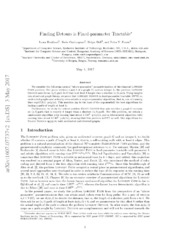Subquadratic Kernels for Implicit 3-Hitting Set and 3-Set Packing Problems
Peer reviewed, Journal article
Accepted version
Permanent lenke
https://hdl.handle.net/1956/22048Utgivelsesdato
2019Metadata
Vis full innførselSamlinger
Originalversjon
https://doi.org/10.1145/3293466Sammendrag
We consider four well-studied NP-complete packing/covering problems on graphs: Feedback Vertex Set in Tournaments (FVST), Cluster Vertex Deletion (CVD), Triangle Packing in Tournaments (TPT) and Induced P3-Packing. For these four problems, kernels with O(k2) vertices have been known for a long time. In fact, such kernels can be obtained by interpreting these problems as finding either a packing of k pairwise disjoint sets of size 3 (3-Set Packing) or a hitting set of size at most k for a family of sets of size at most 3 (3-Hitting Set). In this article, we give the first kernels for FVST, CVD, TPT, and Induced P3-Packing with a subquadratic number of vertices. Specifically, we obtain the following results. • FVST admits a kernel with O(k3/2) vertices. • CVD admits a kernel with O(k5/3) vertices. • TPT admits a kernel with O(k3/2) vertices. • Induced P3-Packing admits a kernel with O(k5/3) vertices. Our results resolve an open problem from WorKer 2010 on the existence of kernels with O(k2−ϵ) vertices for FVST and CVD. All of our results are based on novel uses of old and new “expansion lemmas” and a weak form of crown decomposition where (i) almost all of the head is used by the solution (as opposed to all), (ii) almost none of the crown is used by the solution (as opposed to none), and (iii) if H is removed from G, then there is almost no interaction between the head and the rest (as opposed to no interaction at all).
